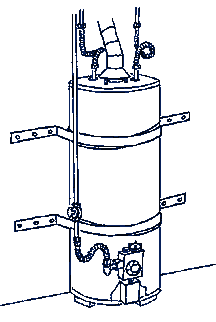How Can We Prepare?
You can prepare for a large earthquake. Heres
how to go about it. Remember that earthquakes are inevitable, but
damage is not!
What you can do now
Make a kit. An emergency kit
should include everything you and your family would need in
order to spend 72 hours on your own.
Make a plan. Create a family
emergency plan and practice it! Be sure a plan is in place
at your workplace or school. If you live near a shoreline,
become familiar with tsunami evacuation routes.
Strap things down. Strap your
hot water heater to the wall (use heavy strapping that completely
encircles the tank). Be sure your house is bolted to the foundation.
Secure other large appliances, bookshelves, and filing cabinets.
Dont hang heavy objects over your desk or bed.
|
 |
What you should do when an earthquake strikes
Drop, cover, and hold. Get under or
beside something bigger than you. Get under a sturdy piece of furniture
and hold on, or lie beside a bed or sofa. Cover your head and wait
for the shaking to stop.

If youre inside, move away from
windows, brick fireplaces, appliances, or anything that could fall.
If youre outside, move to a clear area away from buildings,
trees, poles, and utility wires. If youre outside downtown,
duck into a doorway to protect yourself from falling bricks, glass,
and other debris.

If youre indoors, dont run outside. If youre
driving, pull over and stop at a safe place, and stay in your car
until the shaking stops. And dont forget your family contact
arrangements.
What you should do when the shaking stops
Follow tsunami signs. If youre
near the shoreline in a tsunami hazard area, follow evacuation
signs or head for higher ground.
Check for injuries. Check yourself
and those around you for injuries. Provide assistance to your
neighbors, especially those who may need extra help.
Keep phone lines free. Call 911
only to report a life-threatening emergency. Dont make
local calls right away. Include an out-of-area phone contact
in your family emergency plan. Listen to the radio for news,
instructions, or an official "all clear."
|
 |
| |
During the 2001 Nisqually
earthquake, the land beneath this bike trail liquefied and flowed
into Capitol Lake. |
|

